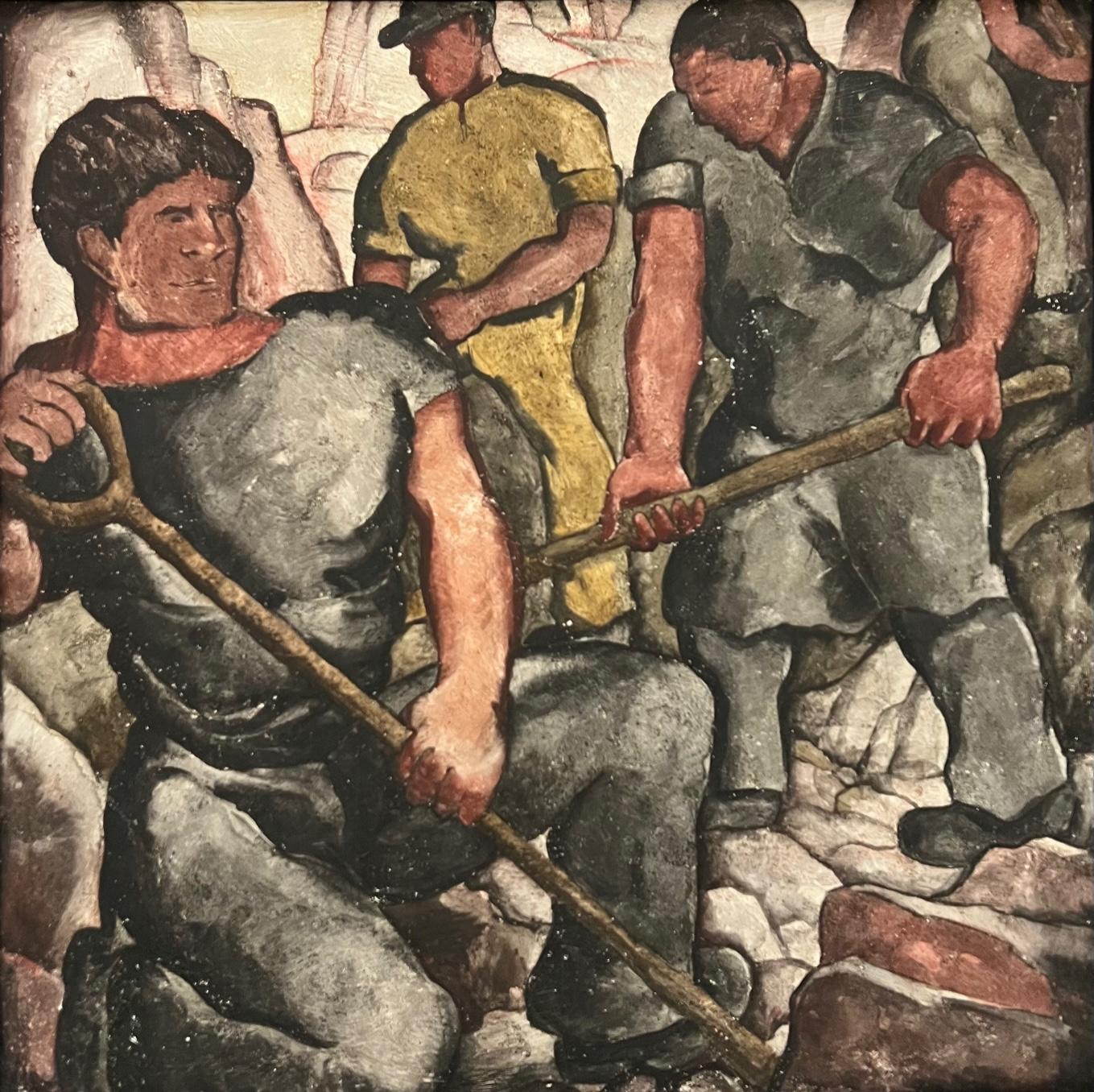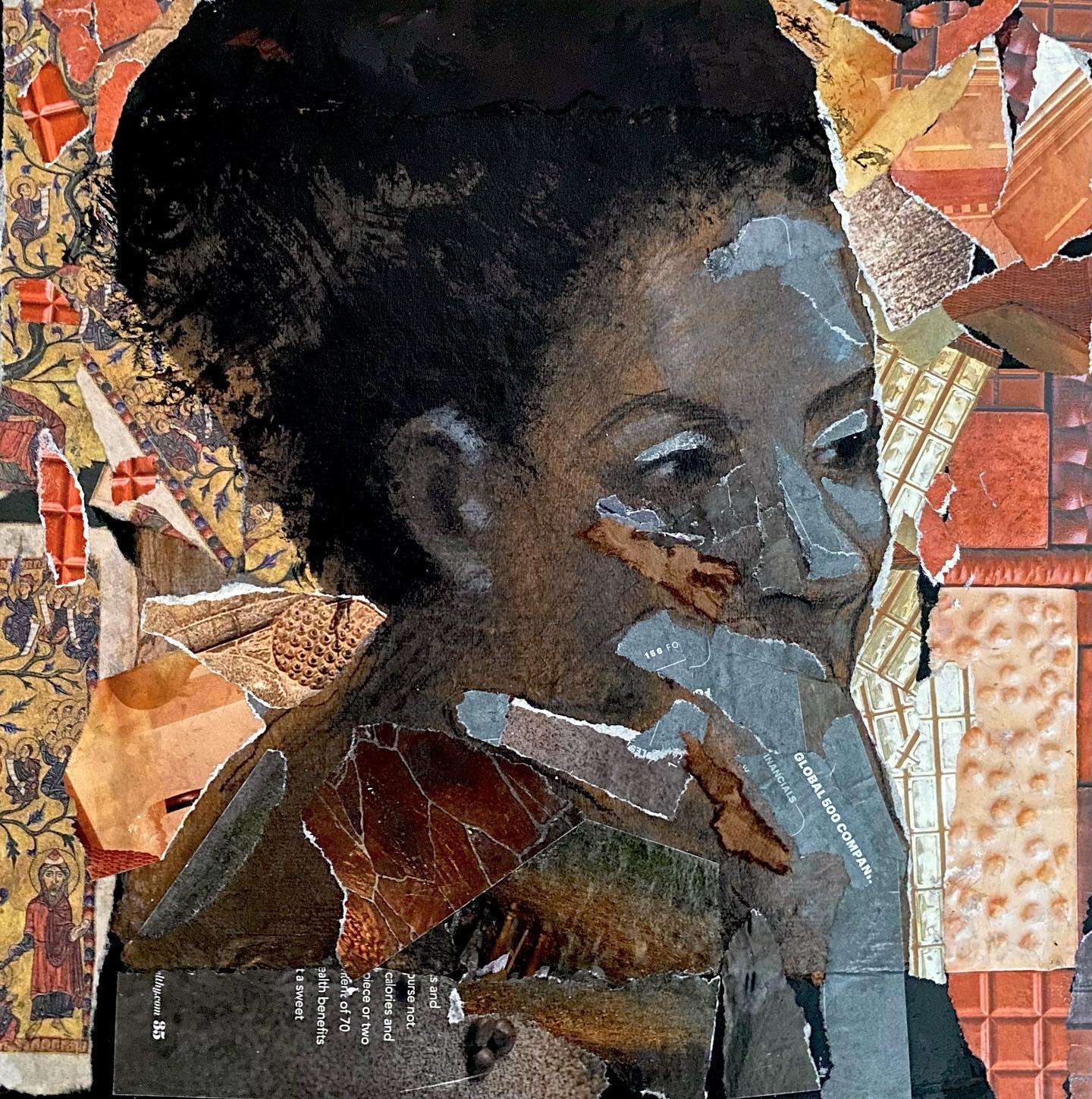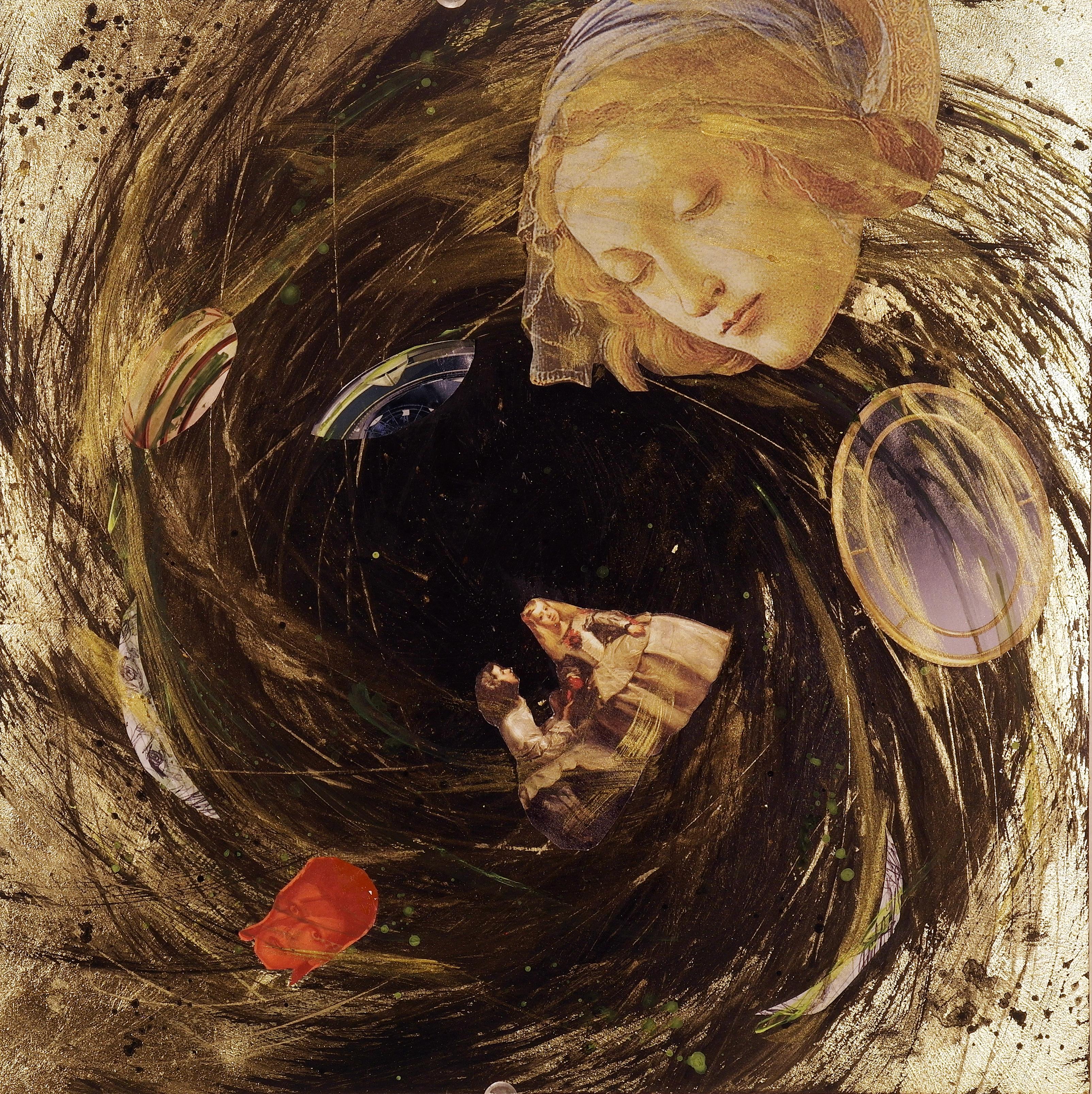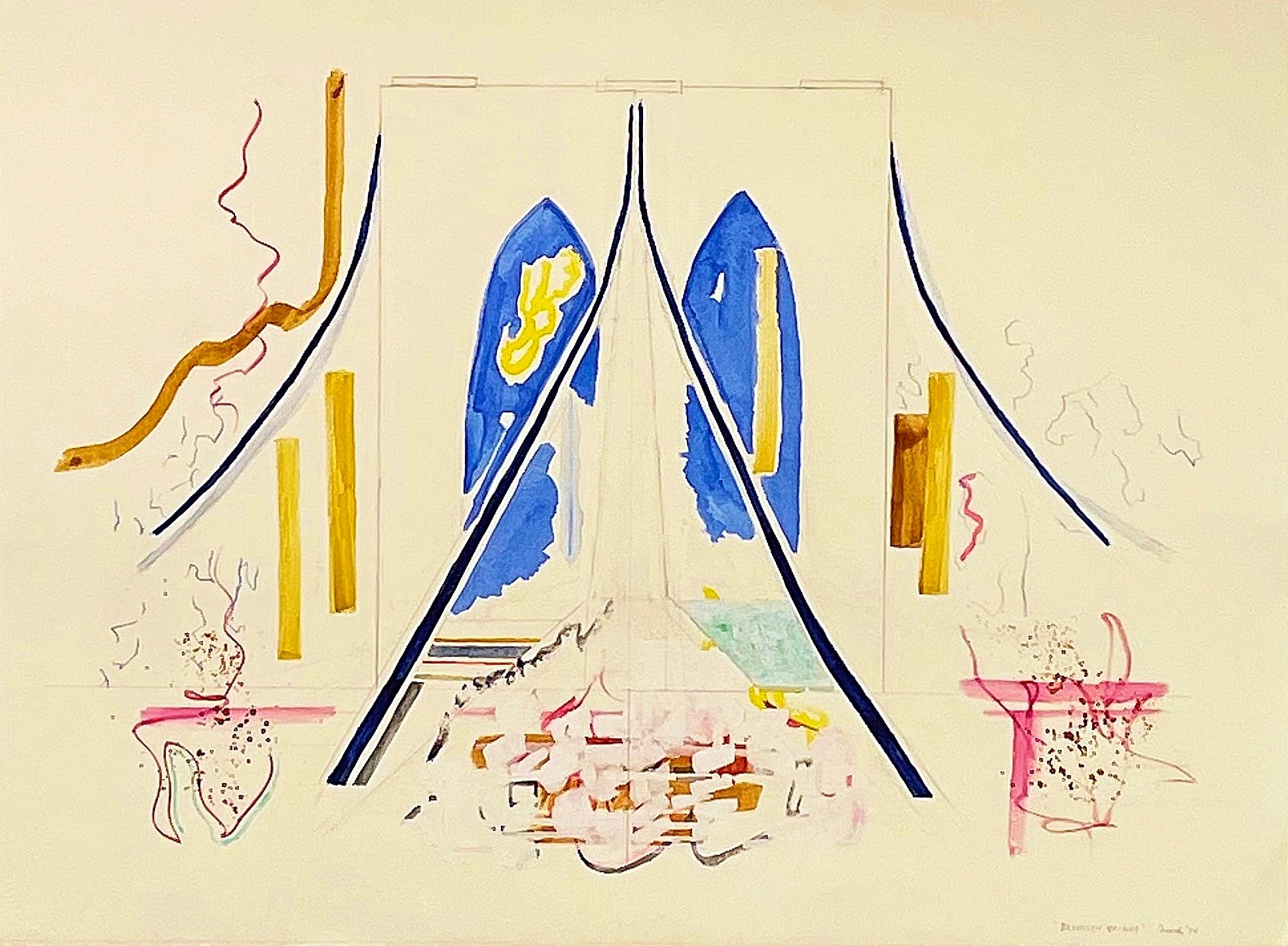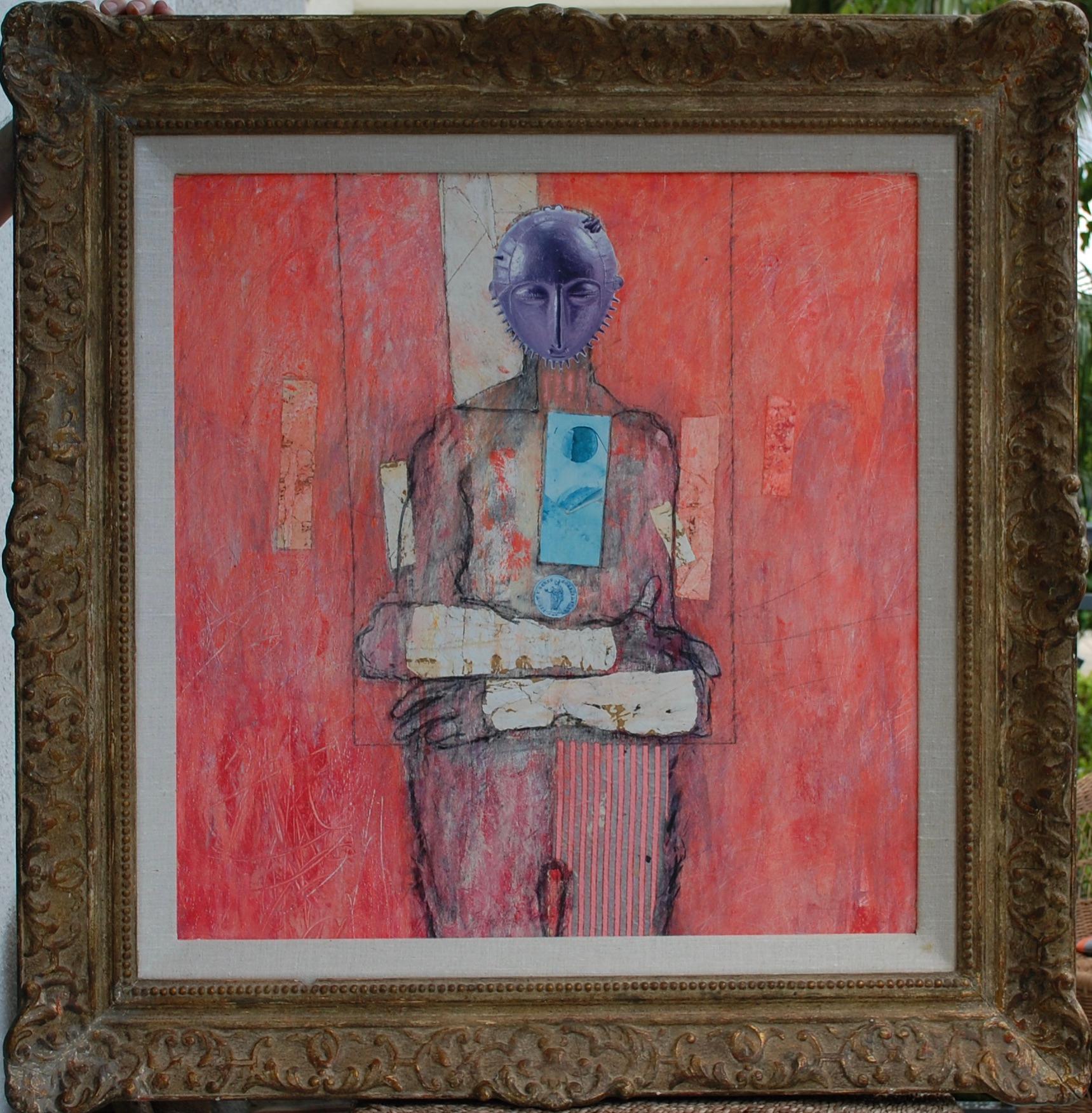Items Similar to What a Life
Want more images or videos?
Request additional images or videos from the seller
1 of 5
Jose Miguel RuelasWhat a Lifec. 1929
c. 1929
About the Item
What a Life, c. 1930, mixed media on board, 18 x 24 inches, signed lower left; titled on label; exhibited at The San Francisco Art Association Fifty-Second Annual Exhibition at the Palace of the Legion of Honor, San Francisco, May, 1930 (label verso)
About the Painting
What a Life is a time capsule. Filled with every imaginable symbol of the Roaring Twenties, Ruelas presents a cornucopia of youth- and beauty-obsessed modern America, from flappers, flashy show girls, pristine skyscrapers, powerful factories, and fast cars to gambling, prohibition era alcohol, tobacco and, of course, money, lots of money. And, in the middle of the composition is a crowned human skull sitting above an overturned paying card of a Joker. This is the world of Gatsby on steroids. Likely painted just months after the stock market crash on October 29, 1929, What a Life seems to pose a deeply personal question for the artist. “Ergo Sumo Ego” (which translates to “Therefore, I chose”) is written on the book binding at the base of the painting. As the Roaring Twenties came to an end and the darkness of the Great Depression descended on the country, many found themselves in a position of having to make profound choices. Ruelas struggled with mental health challenges and chose not to go on. His suicide on November 1, 1930, was national news.
About the Artist
Jose Miguel Ruelas was born in 1901 in Mexico to a Spanish mother and a Mexican father. His father (also named Miguel Ruelas) was a well-known former General in the Mexican army who later became the editor of the San Francisco-based Spanish language journal Hispano America. The family came to the US in 1914 during the early days of the Mexican revolution. Although uncertainty remains, it is likely the younger Ruelas received his art training in the Bay area in the 1920s. By 1930, the US Census listed Ruelas as a professional artist. Like many of his contemporaries, Ruelas worked as a commercial artist and graphic designer. He served as the artistic director of a San Francisco engraving firm.
- Creator:Jose Miguel Ruelas (American)
- Creation Year:c. 1929
- Dimensions:Height: 24 in (60.96 cm)Width: 18 in (45.72 cm)Depth: 1 in (2.54 cm)
- More Editions & Sizes:31 x 25 x 1 inches (framed)Price: $7,500
- Medium:
- Movement & Style:
- Period:
- Condition:
- Gallery Location:Los Angeles, CA
- Reference Number:1stDibs: LU1859210062402
About the Seller
No Reviews Yet
Vetted Seller
These experienced sellers undergo a comprehensive evaluation by our team of in-house experts.
1stDibs seller since 2022
6 sales on 1stDibs
Typical response time: 8 hours
- ShippingRetrieving quote...Ships From: Los Angeles, CA
- Return PolicyA return for this item may be initiated within 3 days of delivery.
More From This SellerView All
- Quarry WorkersLocated in Los Angeles, CAThis painting is part of our exhibition America Coast to Coast: Artists of the 1930s Quarry Workers, c. 1930s, mixed media on board, unsigned, 24 x 24 inches, possibly exhibited at...Category
1930s American Modern Figurative Paintings
MaterialsMixed Media
- San Pedro Post Office: History of Writing Mural South, Preliminary Mural StudyLocated in Los Angeles, CAThis mural study is part of our exhibition America Coast to Coast: Artists of the 1930s San Pedro Post Office: History of Writing Mural South, Preliminary Mural Maquette right panel...Category
1930s American Modern Figurative Paintings
MaterialsMixed Media
- Six O'ClockLocated in Los Angeles, CASix O-Clock, c. 1942, oil on canvas, 30 x 20 inches, signed and titled several times verso of frame and stretcher (perhaps by another hand), marked “Rehn” several times on frame (for the Frank K. M. Rehn Galleries in New York City, who represented Craig at the time); Exhibited: 1) 18th Biennial Exhibition of Contemporary American Oil Paintings from March 21 to May 2, 1943 at The Corcoran Gallery of Art in Washington, D.C. #87, original price $450 (per catalog) (exhibition label verso), 2) Craig’s one-man show at the Frank K. M. Rehn Galleries, New York City, from October 26 to November 14, 1942, #10 (original price listed as $350); and 3) Exhibition of thirty paintings sponsored by the Harrisburg Art Association at the State Museum of Pennsylvania in Harrisburg in March, 1944 (concerning this exhibit, Penelope Redd of The Evening News (Harrisburg, Pennsylvania) wrote: “Other paintings that have overtones of superrealism inherent in the subjects include Tom Craig’s California nocturne, ‘Six O’Clock,’ two figures moving through the twilight . . . .” March 6, 1944, p. 13); another label verso from The Museum of Art of Toledo (Ohio): original frame: Provenance includes George Stern Gallery, Los Angeles, CA About the Painting Long before Chris Burden’s iconic installation outside of the Los Angeles County Museum of Art, Urban Light, another artist, Tom Craig, made Southern California streetlights the subject of one of his early 1940s paintings. Consisting of dozens of recycled streetlights from the 1920s and 1930s forming a classical colonnade at the museum’s entrance, Burden’s Urban Light has become a symbol of Los Angeles. For Burden, the streetlights represent what constitutes an advanced society, something “safe after dark and beautiful to behold.” It seems that Craig is playing on the same theme in Six O-Clock. Although we see two hunched figures trudging along the sidewalk at the end of a long day, the real stars of this painting are the streetlights which brighten the twilight and silhouette another iconic symbol of Los Angeles, the palm trees in the distance. Mountains in the background and the distant view of a suburban neighborhood join the streetlights and palm trees as classic subject matter for a California Scene painting, but Craig gives us a twist by depicting the scene not as a sun-drenched natural expanse. Rather, Craig uses thin layers of oil paint, mimicking the watercolor technique for which he is most famous, to show us the twinkling beauty of manmade light and the safety it affords. Although Southern California is a land of natural wonders, the interventions of humanity are already everywhere in Los Angeles and as one critic noted, the resulting painting has an air of “superrealism.” About the Artist Thomas Theodore Craig was a well-known fixture in the Southern California art scene. He was born in Upland California. Craig graduated with a degree in botany from Pomona College and studied painting at Pamona and the Chouinard Art School with Stanton MacDonald-Wright and Barse Miller among others. He became close friends with fellow artist Milford Zornes...Category
1940s American Modern Landscape Paintings
MaterialsCanvas, Oil
- Subway ConstructionLocated in Los Angeles, CAThis painting is part of our exhibition American Coast to Coast: Artists of the 1930s Subway Construction, c. 1928, oil on board, 19 x 15 ¾ inches, signed upper left, artist and title verso; exhibited: 1) 12th Annual Exhibition of the Society of Independent Artists, The Waldorf Astoria, New York NY, from March 9 to April 1, 1928, no. 864 (original price $250) (see Death Prevailing Theme of Artists in Weird Exhibits, The Gazette (Montreal, Quebec, Canada), March 8, 1928); 2) Boston Tercentenary Exhibition Fine Arts and Crafts Exhibition, Horticultural Hall, Boston MA, July, 1930, no. 108 (honorable mention - noted verso); 3) 38th Annual Exhibition of American Art, Cincinnati Art Museum, Cincinnati, OH, June, 1931 (see Alexander, Mary, The Week in Art Circles, The Cincinnati Enquirer, June 7, 1931); and 4) National Art Week Exhibition [Group Show], Montross Gallery, New York, New York, December, 1940 (see Devree, Howard, Brief Comment on Some Recently Opened Exhibitions in the Galleries, The New York Times, December 1, 1940) About the Painting Ernest Stock’s Subway Construction depicts the excavation of New York’s 8th Avenue line, which was the first completed section of the city-operated Independent Subway System (IND). The groundbreaking ceremony was in 1925, but the line did not open until 1932, placing Stock’s painting in the middle of the construction effort. The 8th Avenue line was primarily constructed using the “cut and cover” method in which the streets above the line were dug up, infrastructure was built from the surface level down, the resulting holes were filled, and the streets reconstructed. While many artists of the 1920s were fascinated with the upward thrust of New York’s exploding skyline as architects and developers sought to erect ever higher buildings, Stock turned his attention to the engineering marvels which were taking place below ground. In Subway Construction, Stock depicts workers removing the earth beneath the street and building scaffolding and other support structures to allow concrete to be poured. Light and shadow fall across the x-shaped grid pattern formed by the wooden beams and planks. It is no surprise that critics reviewing the painting commented on Stock’s use of an “interesting pattern” to form a painting that is “clever and well designed.” About the Artist Ernest Richard Stock was an award-winning painter, print maker, muralist, and commercial artist. He was born in Bristol, England and was educated at the prestigious Bristol Grammar School. During World War I, Stock joined the British Royal Air Flying Corps in Canada and served in France as a pilot where he was wounded. After the war, he immigrated to the United States and joined the firm of Mack, Jenny, and Tyler, where he further honed his architectural and decorative painting skills. During the 1920s, Stock often traveled back and forth between the US and Europe. He was twice married, including to the American author, Katherine Anne Porter. Starting in the mid-1920s, Stock began to exhibit his artwork professionally, including at London’s Beaux Arts Gallery, the Society of Independent Artists, the Salons of America, the Cincinnati Art Museum, the Whitney Studio and various locations in the Northeast. Critics often praised the strong design sensibility in Stock’s paintings. Stock was a commercial illustrator for a handful of published books and during World War II, he worked in the Stratford Connecticut...Category
1920s American Modern Figurative Paintings
MaterialsOil
- Untitled (Elevated Platform)Located in Los Angeles, CAThis painting is part of our current exhibition - America Coast to Coast: Artists of the 1940s Untitled (Elevated Platform), 1950, oil on canvas, signed and dated lower right, 30 x...Category
1950s American Modern Paintings
MaterialsCanvas, Oil
- Riders of Pigeon HillBy Jon CorbinoLocated in Los Angeles, CARiders of Pigeon Hill, c. 1940s, oil on canvas, signed lower right, 24 x 36 inches, label verso with title, artist’s name and address; same information inscribed verso; ex-collection...Category
1940s American Modern Paintings
MaterialsCanvas, Oil
You May Also Like
- Contemplation, charcoal and collage, dark female portrait, brown, orange, goldBy Audrey AnastasiLocated in Brooklyn, NYCollage and acrylic paint on sintra panel, excellent giftCategory
2010s American Modern Figurative Paintings
MaterialsMixed Media, Panel
- Serious Moonlight, abstract figures on gold metal leaf inspired by David BowieBy Audrey AnastasiLocated in Brooklyn, NYCollage and acrylic paint on gold leafed sintra panel, excellent gift Work inspired by David Bowie musicCategory
2010s American Modern Figurative Paintings
MaterialsMixed Media, Panel
- Brooklyn BridgeBy Joe NovakLocated in Lawrence, NYThe Brooklyn Bridge has been an iconic subject of artists for generation. This is contemporary artist Joe Novak's take referencing the early modernist ...Category
2010s American Modern Figurative Paintings
MaterialsMixed Media
- Primus Mixed Media on PanelBy Patrick ArcherLocated in Delray Beach, FLPrimus Artist signed, acrylic and collage on panel, 1993 28x27 with the frame 38x38 Patrick Archer (b. 1926). Archer studied at the California College of Arts and Crafts (MFA). 2002 Philip Hulitar Award, Society of 4-Arts, Palm Beach, FL (A national Contemporary Painting competition) Graduate- Arts & Crafts in Oakland, CA Undergraduate- Principia in Elsah, IL Exhibitions: 2002 Merrill Lynch...Category
1990s American Modern Figurative Paintings
MaterialsAcrylic, Mixed Media, Panel
- Departing from the System, Mid-Century Geometrical Abstract Mixed MediaBy Clarence Holbrook CarterLocated in Beachwood, OHClarence Holbrook Carter (American, 1904-2000) Departing from the System, 1961 Mixed media on paper Signed and dated lower right 36 x 24 inches A surrealist mid-century figural abst...Category
1960s American Modern Abstract Paintings
MaterialsMixed Media
- Up the Avenue, Geometrical Ovoid Abstract Acrylic & Collage CityscapeBy Clarence Holbrook CarterLocated in Beachwood, OHClarence Holbrook Carter (American, 1904-2000) Up the Avenue, 1979 Acrylic and collage on paper Signed and dated lower right 15 x 11 inches A surrealist mid-century figural abstract...Category
1970s American Modern Figurative Paintings
MaterialsAcrylic, Mixed Media
